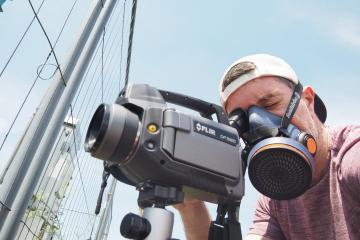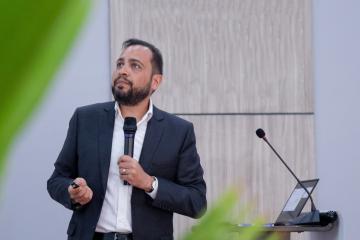
Alumni Voices: The first draft of emissions trading in India

In the early 2010s, market-based mechanisms such as emissions trading were still an untested policy approach to reduce industrial pollution in India. In 2022—after over ten years of laying the regulatory groundwork, evaluating the impact of India’s first emissions trading scheme (ETS) for particulate matter on firms’ pollution levels, and disseminating evidence among policymakers—the Government of Gujarat announced the launch of a carbon trading market for particulate matter in the city of Ahmedabad.
Behind this exciting policy announcement is a story that begins with the J-PAL South Asia alumni who spearheaded early conversations with firms and policymakers to bring this scheme to fruition.
Yuanjian Carla Li (former Senior Research Associate, '12) and Arun Singh (former Research Associate, '15) were among the first few research staff members at J-PAL South Asia who helped spur conversations around emissions trading in India. Working in a previously nebulous regulatory landscape, their contributions towards bringing together diverse stakeholders—including governments, firms, technical partners, and auditors—helped set the stage for what is today considered a promising pathway for curbing pollution and improving air quality in India.
They recount their experiences during the early days of working on studies that have informed one of J-PAL South Asia’s longest running projects.
Yuanjian Carla Li '12 on the Chennai and Gujarat Pollution Control Experiments:
I worked on the endline survey of the Gujarat Pollution Control Experiment and the pilot and scoping stages of the emissions trading scheme in Chennai (which was the precursor to the ETS in Surat).
The pollution control experiment in Gujarat was the first randomised evaluation in South Asia in which we surveyed factories, not people, which also paved the way for the ETS in Surat. The endline survey required a surprise environmental inspection of more than a thousand factories in two months before the onset of the monsoon season, on a limited budget.
It was very difficult to find reliable environmental audit firms to partner with; we called all the environmental firms in the state for a whole day, drove to multiple cities, and pitched the vision of the project to multiple firms. Luckily, we were able to secure a few new partners who were great. However, the pilot and scoping stage of the ETS had its own challenges.
The prerequisite to emission trading was reliable continuous emission monitoring systems (CEMS), which were very new to India and unregulated at the time. This meant that we needed to work with the government to set the required technical regulatory standards. I wrote the first draft of the Continuous Emission Monitoring Standards for India with Mr Dhanasekaran from the Tamil Nadu Pollution Control Board, a fun and challenging experience that I had not expected to work on when I joined as a Research Associate.
Arun Singh '15 on the ETS in Surat:
The design phase of this project was substantially long since the first step involved transitioning from the manual, intermittent monitoring of industrial emissions to continuous emissions monitoring systems (CEMS), a first in the states of Gujarat and Maharashtra. This required designing and implementing hardware and software standards, building the capacity of firms and regulators to install and utilise the new monitoring mechanism, and resolving several unforeseen challenges along the way. It was crucial to the success of the project to get this right since CEMS formed the foundation of measurement on which the emissions market was to be established.
Since we implemented CEMS in Gujarat and Maharashtra from scratch (building on the experience of Tamil Nadu, the first mover in India on CEMS) and conducted a first of its kind industrial survey in India, we faced multiple technical and implementation challenges. These included: adopting global technical standards for the CEMS while ensuring that domestic manufacturers were not disincentivised; repeated delays that risked project implementation; and resistance from firms due to regulatory grievances unrelated to the ETS. At every stage, we had to think on our feet and pivot when required; we consulted extensively with regulators, firms, and CEMS manufacturers and suppliers, came up with transitory solutions, and worked towards gaining the trust of participating firms by assuring them of the confidentiality of their data.
It feels fulfilling to see the substantial groundwork that we laid over seven years ago come to fruition with the implementation of the pilot ETS in Gujarat and expansion of the pilot to Punjab. To me, this demonstrates that perseverance, flexibility, and innovation is essential in implementing any fundamental transformation in policymaking and regulation.
Carla now works as a Group Product Manager at Google Maps and Arun works as an Energy Specialist at the World Bank.
Related Content

Government of Punjab, J-PAL South Asia, and EPIC India launch an Emissions Trading Scheme to reduce industrial air pollution in the state

Alumni Voices: On the front line in the fight against climate change



